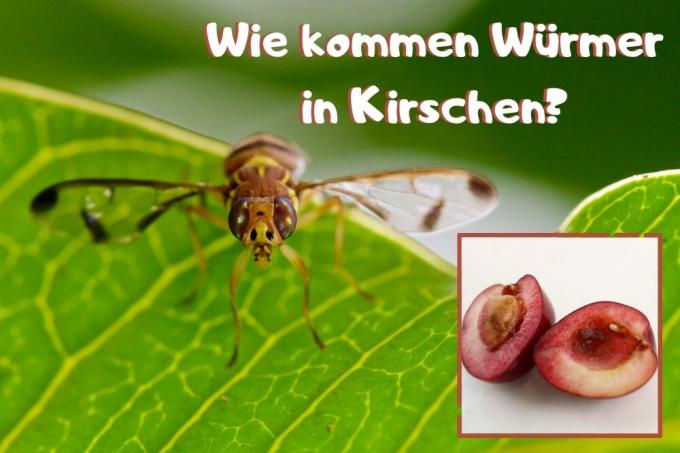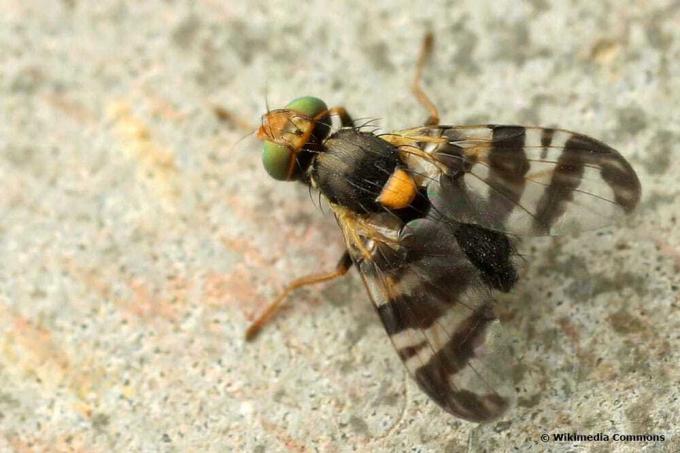
table of contents
- Cherry fruit fly harmful organism
- Vicious circle with an announcement
Stop puzzling over the origin of maggots that spoil your appetite for juicy sour and sweet cherries. This guide explains how nasty worms get into cherries.
Cherry fruit fly harmful organism
Mastermind for Maggot-contaminated cherries is the European cherry fruit fly (Rhagoletis cerasi) from the fruit fly family (Tephritidae). The fly is considered to be the most important pest in cultivating cultivated cherries because it uses the fruits as a breeding station for their offspring. The following appearance makes the cherry fruit fly unmistakable:
- Body drawing: shiny black, light yellow, trapezoidal label on the back
- Wings: clear as glass with dark, transverse bands
- Eyes: green compound eyes
- Body length: 3.5 to 5 mm
- Maggots: creamy white with a length of up to 6 mm

The cherry fruit fly is native and widespread in Europe. The dreaded fruit fly species has specialized in infesting sour cherries and sweet cherries as well as morello cherries. In the absence of favored cultivated cherries, the pests target other fruit trees. These include honeysuckle cherries (Lonicera), common bird cherries (Prunus) and snowberries (Symphoricarpos) with all the resulting varieties.
Tip: Strategically placed safety nets prevent cunning cherry fruit flies from laying eggs, which turn into nasty worms. Cover the tree slice from the end of March / beginning of April. This means that flies that have overwintered in the ground cannot fly out. Wetting the crown from May fends off approaching female cherry fruit flies.
Vicious circle with an announcement
In mid-May, freshly hatched cherry fruit flies fly out of the ground in droves. There they spent the winter in the protection of their pupae at a depth of 3 to 5 centimeters. The insects fly precisely to suitable larval food plants and settle there. In the first 10 to 14 days, the flies first devote themselves to ripening in order to finally strengthen themselves for the upcoming activities. To do this, the pests sit on the leaves and first fruits. On warm spring days, attentive hobby gardeners can watch while flocks of hungry cherry fruit flies feast on the emerging sap.
After the preparation phase, the fatal process begins, as a result of which the bad worms get into the cherries. Mated females wait patiently for the color of the ripening fruits to change from green to yellow or light red and warm and sunny conditions.

- Laying eggs: one at a time, directly under the peel of a cherry
- Maggot hatching: within 5 to 8 days
- first activity: piercing the fruit to the core
- Eating activity: for 30 days, preferably on the pulp around the core
The big eating inside the cherries lasts until the worms are fully grown. In the course of this feeding activity, however, the fruits become rotten and fall half-ripe to the ground. If a fruit mummy gets stuck on the tree, the fully eaten maggot eventually ropes down on a spinning thread. In no time at all, the larvae bury themselves in the ground, where they pupate and hibernate. An average depth of 3 centimeters is sufficient because the stable pupae protect the rabble from freezing frost. When temperatures rise next spring, another vicious circle begins with the hatching.
Note: Did you know that you are putting a spanner in the works with early varieties of the cherry fruit fly? Premium varieties such as “Kassin's early heart cherry”, “Red Maikirsche” or “Burlat” have the critical ones Color change has long been completed when egg-packed females are on the lookout for a suitable place for them Egg laying.



